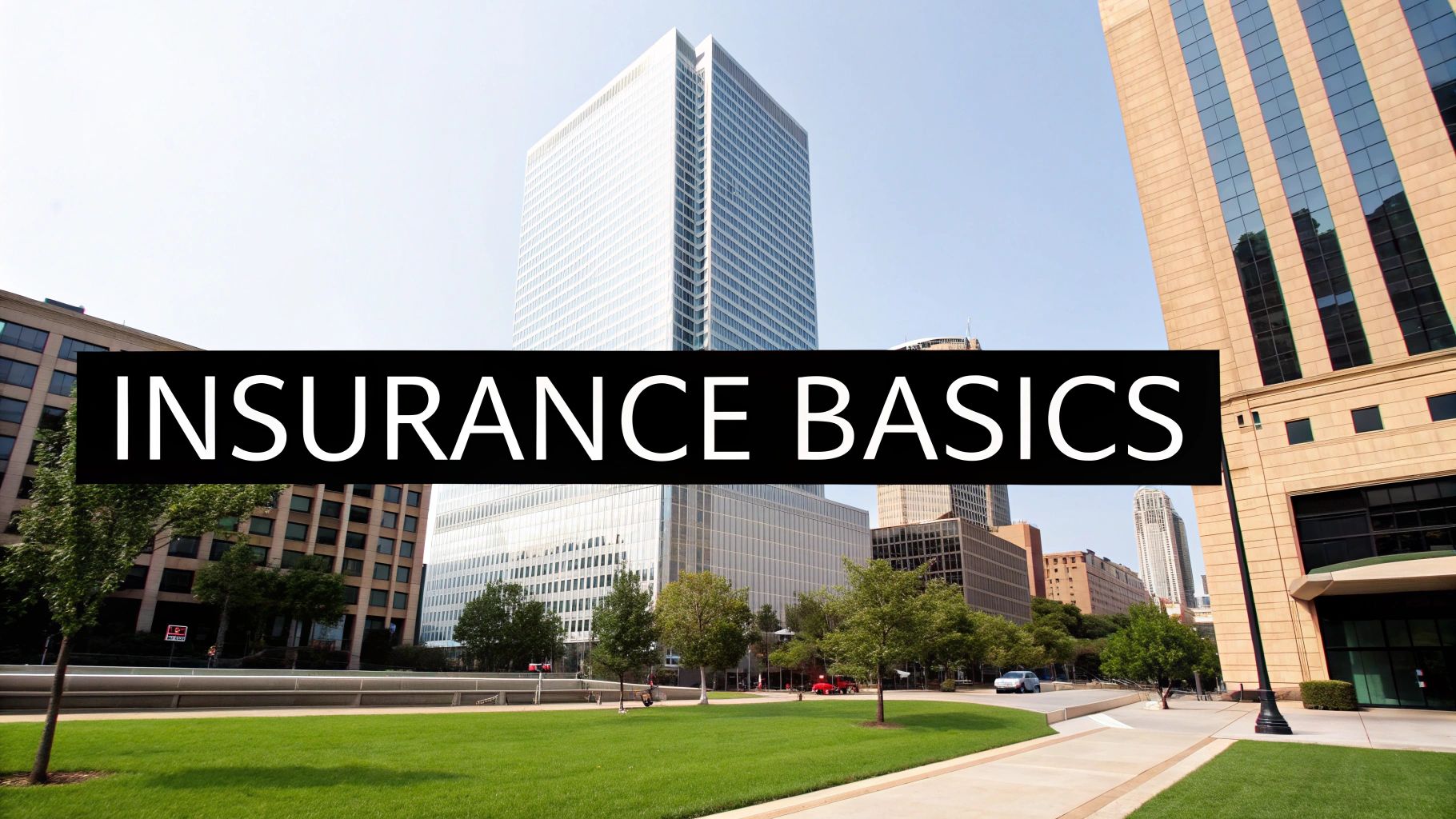Navigating the World of Business Interruption Coverage

Business interruption insurance is a critical part of any comprehensive risk management strategy. It helps businesses navigate unforeseen disruptions by protecting their income stream. This coverage isn't about replacing physical assets; it's about safeguarding your company's financial stability. Even if your physical location is unusable due to a covered event, you can still meet your financial obligations.
Understanding the Difference: Property vs. Business Interruption Insurance
Many business owners mistakenly believe their property insurance covers income losses from disruptions. Standard property insurance primarily focuses on repairing or replacing physical assets damaged by covered perils. Business interruption insurance, however, covers lost income and ongoing expenses while your business is unable to operate. This is a crucial distinction. The financial impact of lost revenue can be far more devastating than the cost of physical repairs. You might be interested in: Exploring Business Insurance Coverage Essentials for Entrepreneurs.
Real-World Applications of Business Interruption Insurance
Imagine a severe storm forces a manufacturer to shut down operations for several weeks. Property insurance would cover the building repairs. But what about the lost revenue from halted production, employee salaries, and fixed costs like rent and utilities? This is where business interruption insurance is essential. It provides a financial safety net, allowing the manufacturer to continue paying its bills and retain its workforce during repairs.
The Importance of Business Interruption Insurance
Business interruption remains a critical concern for organizations globally. According to Aon's 2023 Global Risk Management Survey, it ranks as the second biggest risk facing businesses today. The survey found that despite three-quarters of respondents feeling prepared for business interruption events, nearly a third experienced a loss in the preceding 12 months. This highlights the ongoing vulnerability of companies to disruptions.
The impact of business interruption is significant. It can threaten an organization's survival by affecting revenues, operational costs, and reputation. The complexity of modern supply chains has further increased these risks. Maintaining updated business continuity plans and regularly reviewing insurance coverage are more important than ever.
Key Components of Business Interruption Coverage
Understanding the key components of a business interruption policy is vital. These components often include a waiting period, the time between the incident and coverage commencement, typically 48 to 72 hours. Policies may also offer extended indemnity periods, providing coverage beyond the immediate recovery phase. This is crucial for businesses facing long-term impacts from a disruption. The calculation of actual losses is typically based on historical performance, highlighting the importance of accurate financial records. These components determine the extent of your financial protection and warrant careful consideration when selecting a policy.
Beyond The Basics: What Your Policy Actually Covers
Most business owners, unfortunately, discover gaps in their business interruption insurance only after disaster strikes. Understanding your policy's specific coverage is crucial for effective financial protection. This means knowing precisely what’s included, what’s optional, and what common pitfalls to avoid.
Deciphering Your Policy: Essential Coverage Elements
Standard business interruption insurance policies typically cover net income losses, encompassing profits you would have earned and continuing operating expenses. This often includes payroll, rent, taxes, and loan payments. Think of it as maintaining your business's financial heartbeat during downtime.
Additionally, extra expenses incurred to minimize the interruption, like setting up a temporary location, are often covered. This helps you get back on your feet faster.
Optional Coverage: Enhancing Your Protection
Beyond the basics, consider enhancing your policy with optional coverages. Extended indemnity periods, for instance, extend coverage beyond the immediate recovery period, recognizing that some businesses take longer to fully rebound.
Contingent business interruption insurance is another valuable addition, protecting your business if a key supplier or customer experiences a disruption. This recognizes the interconnectedness of today's business world.
Common Pitfalls: Exclusions and Limitations
Navigating the fine print is essential. Many policies exclude certain events, like floods or earthquakes, requiring separate endorsements. Understanding these exclusions is vital to avoid unexpected coverage gaps.
Coverage limits also warrant careful consideration. Setting limits too low can leave you significantly underinsured, while excessively high limits might unnecessarily inflate your premiums. Finding the right balance is key.
To help illustrate the different coverage levels available, take a look at the comparison table below:
Business Interruption Insurance Coverage Comparison
This table compares standard coverage elements with extended options to help businesses understand their protection options.
| Coverage Element | Standard Policy | Enhanced Policy | Premium Policy |
|---|---|---|---|
| Net Income Loss | Covered | Covered | Covered |
| Extra Expenses | Covered up to a specified limit | Higher coverage limit | Highest coverage limit |
| Extended Indemnity Period | Not Included | Included (e.g., 6 months) | Included (e.g., 12 months) |
| Contingent Business Interruption | Not Included | Included for specified suppliers/customers | Included for a broader range of suppliers/customers |
| Flood Coverage | Not Included | Optional Endorsement | Included |
| Earthquake Coverage | Not Included | Optional Endorsement | Included |
As you can see, the level of protection increases with each policy tier, offering businesses the flexibility to choose the coverage that best aligns with their needs and risk tolerance.
Real-World Examples: The Importance of Comprehensive Coverage
A restaurant forced to close after a fire can use business interruption insurance to pay staff, rent, and utility bills while rebuilding. Similarly, a manufacturer impacted by a supplier's flood can leverage contingent business interruption coverage to offset lost production revenue.
These examples underscore the practical value of a well-structured policy. Business interruption has consistently ranked as a major business risk. The Allianz Risk Barometer 2022 highlighted business interruption as the second most concerning risk, underscoring its pervasive nature.

Tailoring Coverage To Your Unique Needs
The right business interruption insurance policy should reflect your unique risk profile. Consider your industry, business model, revenue fluctuations, and dependencies on suppliers or customers.
Working with an experienced insurance professional can help you identify vulnerabilities and tailor your coverage accordingly. This proactive approach ensures your policy provides a robust safety net, enabling a swift and complete recovery when disruptions occur.
The True Financial Impact of Business Disruptions

Beyond the premiums and policy details of business interruption insurance lies the stark reality of what disruptions truly cost. Understanding this impact is crucial for making informed decisions about your insurance needs and overall business resilience.
The Obvious Costs: Lost Revenue and Ongoing Expenses
The most immediate financial consequences of a disruption are often the most apparent: the loss of revenue and the continuing burden of fixed expenses. Imagine a retailer forced to close due to a fire. Daily sales vanish, yet rent, utilities, and employee salaries still need to be paid. These ongoing costs can rapidly deplete a company's reserves, especially during prolonged closures. Even a short interruption can inflict a significant financial blow.
This underscores the importance of having a financial safety net in place. Tools like QuickBooks can help businesses track their expenses and revenue, giving them a clearer picture of their financial position.
The Hidden Costs: Long-Term Damage
Beyond the immediate losses, the true financial impact often extends much further. Unprepared businesses can face devastating hidden costs.
- Market share erosion
- Customer defection
- Reputational damage
For instance, if customers are forced to find alternative suppliers during a disruption, they may not return even after the business reopens. This loss of customer loyalty can have long-term consequences for profitability.
The Growing Cost of Interruptions
The financial impact of business interruptions is substantial and continues to rise. The average cost of a business interruption insurance claim has grown significantly, reaching $2.38 million recently. This is 36% higher than the average of $1.75 million for direct property damage. This increase reflects the growing interconnectedness of businesses and the complexity of modern supply chains. You can find more detailed statistics here.
To better understand the financial ramifications across different sectors, let's look at the following table:
Average Business Interruption Costs by Industry: This table presents statistical data on average interruption costs across different industry sectors.
| Industry | Average Daily Revenue Loss | Average Recovery Time | Total Impact Cost |
|---|---|---|---|
| Retail | $10,000 | 14 days | $140,000 |
| Manufacturing | $50,000 | 21 days | $1,050,000 |
| Hospitality | $25,000 | 7 days | $175,000 |
| Technology | $100,000 | 30 days | $3,000,000 |
This table represents example data for illustrative purposes only and may not reflect current market conditions.
As this data illustrates, the total impact cost can vary drastically depending on the industry. The technology sector, for example, faces a much higher potential impact compared to retail. This highlights the importance of tailoring insurance coverage to the specific needs and vulnerabilities of each individual business.
Calculating Your Potential Losses
Determining the potential financial impact of a disruption requires a thorough assessment of your specific business model. Practical calculation methods tailored to your industry can help quantify potential losses. A manufacturer, for instance, might calculate the potential lost revenue based on its daily production capacity and average sales price. Understanding these figures is crucial for effective financial planning and risk management.
Further reading: The Hidden Costs of Poor Health: Understanding Life Insurance Rates.
Benchmarking Your Exposure
Understanding how your potential losses compare to industry standards is essential. Benchmarking your potential exposure can help you determine appropriate coverage limits and deductibles for your business interruption insurance. This allows you to align your insurance coverage with your company's specific risk tolerance and financial resilience. This knowledge empowers you to choose coverage limits that provide adequate protection without unnecessary expense. By understanding the full spectrum of potential financial impacts, you can make well-informed decisions that safeguard your business's long-term financial health.
Setting Coverage Limits That Actually Protect You

Setting the right coverage limits for your business interruption insurance is crucial. Arbitrary limits can leave your business exposed in a crisis, while excessive limits lead to unnecessary expenses. A thoughtful approach tailored to your specific situation is essential.
Calculating Appropriate Coverage Limits
Smart businesses base their business interruption insurance needs on a comprehensive analysis of their financial vulnerabilities. This involves realistically assessing potential revenue loss during a temporary closure. Several key factors contribute to this calculation.
-
Seasonal Revenue Fluctuations: Businesses experiencing peak seasons, like retailers during the holidays, must consider their highest potential losses. A toy store, for example, might require higher coverage during the holiday rush compared to the slower summer months.
-
Growth Projections: Your coverage should align with your anticipated growth. If you project a 20% revenue increase next year, incorporate this into your calculations to prevent being underinsured.
-
Industry-Specific Recovery Timelines: Recovery times vary across industries. A restaurant might reopen within weeks of a fire, while a manufacturer could face months of rebuilding. Your coverage needs to reflect your estimated downtime.
Conducting a Business Impact Analysis
Collaborating with insurance professionals can facilitate a thorough business impact analysis. This process pinpoints your financial vulnerabilities during an interruption, encompassing all potential income losses and ongoing expenses. It forms the basis for setting appropriate coverage limits and deductibles. For further guidance, explore our resource on Protecting Your Business: A Guide to Liability Insurance Coverage Limits.
Adjusting Coverage as Your Business Evolves
Businesses are constantly changing. Your insurance coverage must adapt to your growth and operational shifts. Regularly reviewing and adjusting your business interruption insurance is vital. This helps avoid both the financial strain of underinsurance and the wasted expense of overinsurance.
Case Studies in Coverage Adjustment
Consider a rapidly expanding tech startup. As their revenue climbs, so does their need for business interruption coverage. Proactively adjusting their limits ensures adequate protection if a disruption occurs.
Conversely, an established business might see its coverage needs decrease as operations diversify and reliance on a single location or product diminishes. Adjusting coverage downwards can offer cost savings without sacrificing essential protection.
Ensuring Meaningful Protection
Setting the right coverage limits is about more than just numbers; it's about ensuring your policy truly protects you when it matters most. A well-designed policy provides the financial support needed to weather disruptions, allowing you to prioritize recovery over mere survival.
Creating a Business Continuity Plan That Actually Works
Business interruption insurance is a vital safety net. However, its true strength comes when paired with a solid business continuity plan. This plan guides you through disruptions, minimizing downtime and ensuring a quick recovery. It’s the proactive counterpart to your reactive insurance policy.
Identifying Critical Business Functions
The first step in building an effective business continuity plan is pinpointing your critical business functions. These are the core processes essential for revenue generation and customer service. For a manufacturer, this might be production and distribution. For a retailer, it could be sales and customer service. Prioritizing these functions is key for efficient resource allocation during a disruption.
Establishing Realistic Recovery Timeframes
After identifying your critical functions, establish realistic recovery timeframes, known as Recovery Time Objectives (RTOs). This involves estimating the maximum downtime each function can tolerate before significantly impacting your business. An e-commerce business, for instance, might have a shorter RTO for its website than for its administrative functions. These timeframes shape your recovery strategies and help you prioritize.
Creating Actionable Procedures
A practical continuity plan requires clear, step-by-step procedures. Your team should be able to easily follow these during a crisis. Procedures should outline specific actions, responsibilities, and communication protocols. An example procedure might detail how to activate backup systems, contact key personnel, or communicate with customers during a disruption. Detailed, actionable procedures allow for a more effective response under pressure.
Documenting Essential Processes
Thorough documentation is essential. Document everything: contact information, system configurations, and vendor agreements. This information must be readily accessible and easy to understand, even for team members less familiar with specific procedures. Think of this documentation as a user manual for navigating a crisis.
Establishing Clear Communication Protocols
Effective communication is crucial during disruptions. Establish clear communication protocols outlining how information will be shared internally and externally. This might involve assigning a spokesperson, establishing communication channels, and preparing pre-written messages to keep stakeholders informed. This prevents misinformation and keeps everyone aligned.
Assigning Team Responsibilities
Assign specific responsibilities to each team member within the continuity plan. This clarifies everyone's role during a crisis, minimizing confusion and facilitating quick action. Clearly defined roles and responsibilities improve accountability and efficiency. Regularly review and update these assignments as team structures and roles change.
Testing Your Continuity Plan
Finally, regularly test your continuity plan with realistic simulations. This helps identify weaknesses and refine procedures. Consider these simulations as fire drills for your business—practice runs for handling disruptions. Simulations might involve role-playing various scenarios, testing communication systems, or activating backup procedures. Testing strengthens your plan and prepares your team to respond calmly and efficiently in a real emergency. Combining comprehensive business interruption insurance with a well-developed business continuity plan creates a strong shield against disruptions, protecting your business’s financial health and long-term viability.
Mastering the Claims Process to Maximize Recovery
When disaster strikes and your business operations are interrupted, navigating the business interruption insurance claims process becomes critical. A smooth and efficient process can be the difference between a quick financial recovery and a protracted struggle. This section provides a roadmap to help you maximize your recovery.
Pre-Loss Preparation: Setting the Stage for Success
Before any disruption, take proactive steps to prepare for a potential claim. This pre-loss preparation is essential. Maintaining accurate and detailed business records is crucial. Detailed financial statements, comprehensive sales records, and thorough expense reports are fundamental for substantiating your claim. Imagine trying to piece together your financial history after a fire. This highlights the importance of well-organized and easily accessible documentation.
Documenting Losses: Building a Compelling Case
When you file a claim, thorough documentation is paramount. This involves compiling a complete record of all losses incurred due to the business interruption. This includes several key areas:
- Lost Revenue: Document anticipated sales based on historical performance, showing the income your business would have generated if the interruption hadn't occurred.
- Ongoing Expenses: Provide evidence of continuing expenses such as rent, utilities, and payroll that your business incurred despite the closure.
- Extra Expenses: Document any additional costs your business incurred to mitigate the interruption, like setting up a temporary location or accelerating repairs.
Gathering Compelling Evidence: Supporting Your Claim
Beyond financial documentation, gather supporting evidence to strengthen your claim. Photographs, videos, and witness testimonials can corroborate the extent of the damage and how it impacted your business operations. This evidence offers a visual and personal account of the disruption, supporting the legitimacy of your claim.
Effectively Presenting Your Case to Insurers
Effective communication with your insurer is vital throughout the entire claims process. Clearly explain your losses, providing all requested documentation promptly. Maintaining open communication and responding quickly to inquiries can help avoid delays. Consider your insurer as a partner in your recovery—clear and consistent communication strengthens this partnership.
Common Mistakes and How to Avoid Them
Understanding common pitfalls in the claims process can save you time and resources. Inadequate documentation, inaccurate loss calculations, and delayed reporting are common errors that can lead to denied claims or reduced settlements.
Here’s a table outlining common mistakes and strategies to avoid them:
| Mistake | How to Avoid It |
|---|---|
| Inadequate Documentation | Maintain detailed records of all business activities and financial transactions. |
| Inaccurate Loss Calculations | Consult with a forensic accountant or financial professional to accurately assess all losses. |
| Delayed Reporting | Report the business interruption to your insurer immediately following the event. |
| Lack of Communication | Maintain proactive and open communication with your insurer throughout the process. |
Understanding Proof-of-Loss Provisions
Your business interruption insurance policy includes specific proof-of-loss provisions. These outline the necessary documentation and the timeframe for submitting your claim. Understanding these provisions is crucial to ensure your claim meets all requirements. Familiarize yourself with these provisions before any disruption occurs so you’re prepared to act quickly and efficiently when needed.
Real-World Examples: Success Stories in Claims Management
Businesses that have meticulously documented their losses and communicated effectively with their insurers have successfully navigated complex business interruption claims. For example, a restaurant forced to close after a fire fully recovered its lost income and extra expenses. This was achieved by providing detailed financial records, photographs of the damage, and a thorough record of expenses incurred during the rebuilding process. These examples highlight the importance of comprehensive preparation and effective communication in securing a full recovery.
By understanding and actively managing the claims process, you can transform the promises of your business interruption insurance policy into genuine financial recovery when your business faces significant challenges. This proactive approach ensures that your coverage delivers the essential financial support it was designed to provide.
Comments are closed.